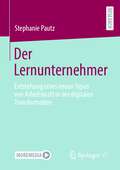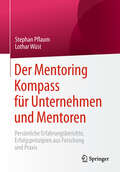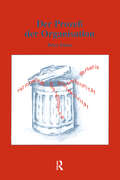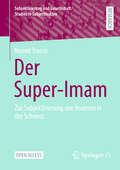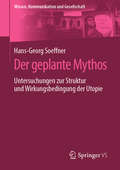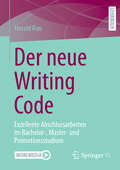- Table View
- List View
Der Lernunternehmer: Entstehung eines neuen Typus von Arbeitskraft in der digitalen Transformation
by Stephanie PautzDie digitale Transformation beschreibt den derzeitigen gesellschaftlichen Veränderungsprozess, der maßgeblich durch die Weiterentwicklung von Informationstechnologien bestimmt wird. Das Thema Lernen rückt damit in den Fokus. Menschen können darüber aktiv diesen Wandel gestalten und sich anpassen, um ihre grundlegenden psychologischen Bedürfnisse nach Kompetenzerleben, sozialer Eingebundenheit und Autonomie zu befriedigen. Allerdings verdichten sich auch die Anforderungen an sogenannte Wissensarbeiter, die in diesem Buch fokussiert werden. Herauszufinden wie sich die Arbeit durch Lernen verändert, bildet den Schwerpunkt. Ausgangspunkt ist die Arbeitskraftunternehmer-These, die Ende des 20. Jahrhunderts formuliert wurde. Thematisiert wird eine weitere Subjektivierung von Arbeit durch die Abkehr vom tayloristisch-fordistischen Arbeitsmodell. Den Arbeitskraftunternehmer zeichnet ein unternehmerischer Umgang mit der eigenen Arbeitskraft aus. In diesem Buch wird ein neues Modell eines Arbeitskrafttypus (Lernunternehmer) entwickelt, auf dessen Basis der weitere Wandel von Arbeit und Lernen untersucht wird. Die Schlussfolgerungen zu dieser Untersuchung bilden die Basis für entsprechende Handlungsempfehlungen zur Gestaltung arbeitsorientierten Lernens und lernhaltigen Arbeitens von Wissensarbeitern.
Der Mensch im Fokus der digitalen Arbeitswelt: Wirtschaftspsychologische Perspektiven und Anwendungsfelder
by Melanie HasenbeinDieses Fachbuch zeigt Ihnen auf, welche Auswirkungen die Digitalisierung auf den Menschen in der heutigen Arbeits- und Organisationswelt hat. Dabei begleitet Sie das Werk auf der digitalen Reise durch die wirtschaftspsychologischen Themenbereiche. Basierend auf gut vermitteltem theoretischen Hintergrundwissen und fundiert mit aktuellen Studien und praktischen Umsetzungsmöglichkeiten erfahren Sie:zentrale Veränderungen im Organisations- und Personalbereich welche Führungsansätze und -kompetenzen in digitalen Zeiten relevant sind welchen Einfluss dies auf die Teamarbeit hatwelche aktuellen digitalen Lernformate Anwendung finden undwelche Bedeutung die Themen digitale Balance und Ethik in der Digitalisierung haben.Zielgruppen:Professionals im Organisations- und Personalbereich sowie Berater, Coaches und Trainer als auch Studierende der Wirtschaftspsychologie und der Angewandten Psychologie. Zur Autorin: Dr. Melanie Hasenbein ist als Organisationsdesignerin und Coach für digitale Veränderungsprozesse und als Autorin zu Themen der digitalen Psychologie und Pädagogik tätig.
Der Mensch spiegelt sich im Blick der Tiere: Auflösung und Neudefinition des Menschen in der Exilliteratur (Exil-Kulturen #9)
by Carla SwiderskiWas ist der Mensch und wie verhält er sich zum Tier? Wird diese Frage in ethischen, gesellschaftlichen, philosophischen und ästhetischen Diskursen seit der Antike debattiert, stellt sie sich im 20. Jahrhundert angesichts der NS-Diktatur und ihrer Verbrechen gegen die Menschlichkeit in einem besonders bedrohlichen Umfeld. Wie wirkt sich dies auf das nachfolgende Verständnis von Mensch und Tier aus? – Die vorliegende Arbeit untersucht Mensch-Tier-Konstellationen in fiktionalen und theoretischen Texten, die im durch das NS-Regime verursachten Exil entstanden sind. Dabei werden Fragen der Exilforschung mit Fragen der Literary und Cultural Animal Studies zusammengedacht. Ausführlich analysiert werden Texte von Victor Klemperer, Alexander Bein, Hannah Arendt, Max Horkheimer und Theodor W. Adorno, Hermann Broch, Oskar Maria Graf, Alfred Kerr, Hilde Domin und Hans Sahl.
Der Mentoring Kompass für Unternehmen und Mentoren: Persönliche Erfahrungsberichte, Erfolgsprinzipien aus Forschung und Praxis
by Stephan Pflaum Lothar WüstMentoring ist ein vielversprechendes Beratungskonzept, um die Karrieren junger Akademiker und Fachkräfte gezielt zu fördern. Das vorliegende Arbeitsbuch richtet sich gleichermaßen an Mentoren und Mentees, die eine Mentoringbeziehung während des Studiums oder am Beginn ihrer Karriere aufbauen und erfolgreich gestalten wollen. Neben einer Einführung in die grundlegenden Methoden der Beratung im Mentoringprozess bietet das Buch eine anwendungsorientierte Best-Practice-Sammlung zur erfolgreichen Gestaltung der Beziehung zwischen Mentor und Mentee.
Der ProzeB der Organisation
by Peter PelzerFirst Published in 1995. Das Buch ist ein ernsthafter Versuch, die anregende Wirkung der Auseinandersetzung mit anderen Wissensgebieten aufzuzeigen, die auf den ersten Blick nichts mit dem eigenen Arbeitsfeld zu tun haben, sondern die Wahrnehmung von Entwicklungen schärfen, die nur in einem breiteren Wettbewerb bewertet werden können, wird mit einer Untersuchung des gegensätzlichen Paares von Subjektivismus und Objektivismus fortgesetzt, gefolgt von einer Auseinandersetzung mit dem Konzept der Postmoderne. Im vierten Teil werden die Konzepte der ersten beiden Teile im Lichte des dritten Teils erneut untersucht.
Der Russland-Ukraine-Krieg: Lösungsperspektiven aus der Friedensforschung (Innovativ und kompakt – gesellschaftliche Herausforderungen der Gegenwart)
by Karim FathiDer Krieg in der Ukraine hält die Welt in Atem. Die aktuelle Berichterstattung ist emotionalisiert und beschränkt sich weitgehend auf die militärischen Entwicklungen des Kriegsverlaufs. Beiträge der Friedens- und Konfliktforschung wurden und werden in der aktuellen Debatte nur unzureichend berücksichtigt. Sie sind sogar Gegenstand antipazifistischer Kritik. Wenig findet sich zu der Frage, was für einen nachhaltigen Frieden notwendig wäre. Diese Frage ist umso wichtiger, als dieser Krieg in seinen Tiefendimensionen eine hochbrisante globale Tragweite aufweist, mit indirekten Verbindungen zu anderen Territorialkonflikten, wie z.B. dem China-Taiwan-Konflikt. Parallel zum Krieg ist eine zunehmende globale Blockbildung zwischen Ost und West mit ungewissem Ausgang zu beobachten. Einige Beobachter*innen sprechen von einem „Neuen Kalten Krieg“ mit den beiden Supermächten USA und China sowie der EU und Russland als Hauptakteuren. Gleichzeitig scheint der Krieg als Katalysator für eine neue multilaterale Weltordnung zu wirken. Das Buch skizziert in knapper und allgemeinverständlicher Form, wie eine multidimensionale Analyse komplexer Konflikte wie des Russland-Ukraine-Krieges angegangen werden kann und wie sich daraus auch Ansätze für eine komplexitätsadäquate Konfliktintervention und Außenpolitik ableiten lassen. Darüber hinaus werden Impulse für die Weiterentwicklung der Friedensforschung zu einem multiparadigmatischen Forschungsfeld gegeben.
Der Staat als ‚Guter Auftraggeber‘? Öffentliche Auftragsvergabe zwischen Vermarktlichung und Sozialpolitisierung
by Karen Jaehrling Christin StiehmDiese Open-Access-Publikation befasst sich mit den vielfältigen Entscheidungsprozessen, mit denen der Bieterwettbewerb um öffentliche Aufträge gestaltet wird und fragt, inwieweit dabei versucht wird, gute Arbeitsbedingungen für die Beschäftigten beauftragter Unternehmen zu gewährleisten. Inwieweit bemüht sich der Staat als ‚Guter Auftraggeber‘ die Lücken der kollektiven Selbstregulierung des Arbeitsmarktes (durch Tarifverträge, betriebliche Mitbestimmung) zu schließen – oder trägt im Gegenteil dazu bei, sie zu vertiefen? Neben einer Analyse der Gesetzesentwicklung auf europäischer und nationaler Ebene bilden Fallstudien zur Vergabepraxis auf kommunaler Ebene in Deutschland das Kernstück der empirischen Erhebung. Die Befunde verdeutlichen, dass die Vergabepolitik und -praxis durch widersprüchliche Trends geprägt wird: Zum einen durch die Intensivierung von Marktprinzipien (Vermarktlichung), indem Regelungen und Praktiken, die dem Bieterwettbewerb zugunsten sozialer Ziele Schranken setzen, seit Beginn des Europäischen Binnenmarktes an immer restriktivere Bedingungen geknüpft worden sind. Dem stehen zum anderen verschiedene Ansätze gegenüber, sozialen Kriterien bei der Auftragsvergabe einen größeren Stellenwert einzuräumen (Sozialpolitisierung) – etwa durch Tariftreuebestimmungen. Dieses dauerhafte, institutionalisierte Nebeneinander widersprüchlicher Trends generiert Handlungsdilemmata für die kommunale Politik und Verwaltung, wie auch für die Akteure der industriellen Beziehungen. Das Buch beleuchtet ihre Strategien und Lernprozesse im Umgang mit diesen Dilemmata.
Der Strafvollzug als Zwischenstation der Radikalisierung: Eine Studie zu Strafgefangenen und Haftentlassenen muslimischen Glaubens anhand biographisch-narrativer Gesprächsführung (Islam in der Gesellschaft)
by Samet ErEs gibt nur wenige wissenschaftliche Forschungen zur islamistischen Radikalisierung im Strafvollzug. Auch ist wenig erforscht, wie mit diesem Phänomen umzugehen ist. Es fehlen Informationen darüber, welche Personen oder -gruppen sich im Strafvollzug oder nach der Entlassung radikalisiert haben. Das liegt u.a. an den spärlich vorhandenen und kaum verwertbaren Daten und Erfahrungswerten, da es sich noch um ein relativ junges Phänomen handelt. Im Buch werden (radikalisierte) Strafgefangene und Haftentlassene mehrmals und über einen längeren Zeitraum hinweg interviewt, um sie und ihr bisheriges Leben anhand ihrer Selbstdarstellung besser verstehen und nachvollziehen zu können. Die Auswertungen zeigen, dass Prozesse der Radikalisierung mit biographischer Sinnsuche und den Erfahrungen im Strafvollzug zusammenhängend auch nach der Entlassung stattfinden können.
Der Super-Imam: Zur Subjektivierung von Imamen in der Schweiz (Subjektivierung und Gesellschaft/Studies in Subjectivation)
by Noemi TruccoIn diesem Open-Access-Buch wird untersucht, wie Imame in der Schweiz mit den vielfältigen Anrufungen, Adressierungen, Zuschreibungen und Erwartungen in massenmedialen und politischen Debatten umgehen. Anhand einer empirischen Subjektivierungsanalyse wird die Machtwirkungen von Diskursen auf Selbst-Positionierungen von Imamen aufgezeigt. Herausgearbeitet wird, wie sich die spezifischen Debatten als konflikthafte Aushandlungen zur symbolischen Form der Schweizer Gesellschaft, die von einer Abgrenzung zum Fremden und damit einer sozialen Schließung geprägt sind, auf die Selbst-Positionierungen niederschlagen, aber auch in welcher Form Imame dennoch Agency haben.
Der Transparenz-Imperativ: Normen – Praktiken – Strukturen
by Vincent August Fran OsreckiDie Forderung nach „mehr Transparenz“ ist allgegenwärtig. Der Transparenz-Imperativ beschränkt sich dabei nicht auf die Politik; man begegnet ihm auch in Wirtschaft und Wissenschaft, im Journalismus und im Gesundheitssystem. Wie konnte sich diese Norm derart durchsetzen? Hält Transparenz ihr Versprechen, mehr Vertrauen, Effizienz und Partizipation zu schaffen? Wie gestalten sich Strukturen, die im Namen von mehr Transparenz geschaffen wurden? Und wem nützen sie? Diese Fragen nimmt der Band in den Blick. Durch die Zusammenführung unterschiedlicher sozialwissenschaftlicher Ansätze wird deutlich: Transparenz ist eine modernistische Regierungsweise, die Misstrauen in Praktiken der Inspektion übersetzt. Sie macht soziale Prozesse für externe Laien sichtbar, indem sie standardisiert und formalisiert. Dabei erreicht sie aber selten das von ihr anvisierte Ziel: Transparenz schafft oft Intransparenz.
Der Umgang mit Differenz in der Polizeiarbeit: Eine auto-ethnografische Untersuchung
by Marcel MüllerIn dieser (auto-)ethnografischen Studie geht es in erster Linie um die Frage, wie sich verschiedene Differenzen – etwa sprachliche, ethnische, kulturelle oder sozio-ökonomische Unterschiede – auf die polizeiliche Praxis auswirken und wie Polizist*innen im Rahmen der Polizei-Bürger-Interaktion üblicherweise mit den verschiedenen Fremdheitsmarkierern umgehen. In diesem Kontext ist vor allem von Interesse, welche Ansätze und Strategien die Polizeibeamt*innen verfolgen, um die auftretenden (Verständnis-)Probleme im Alltag zu lösen und was geschieht, wenn es ihnen nicht gelingt, die auftretenden Differenzen zu überwinden. Dabei ist gleichermaßen von Bedeutung, in welchen Situationen die Beteiligten konkret zu einer Kulturalisierung (oder Entkulturalisierung) der Interaktion beitragen und was sie sich hiervon in der Regel versprechen. Hierbei fokussiert die Untersuchung ebenso auf die hiermit verbundenen Grenzziehungspraktiken der beteiligten Akteur*innen – und zwar nicht nur im Hinblick auf Polizei-Bürger-Interaktion, sondern auch hinsichtlich des Binnenlebens der Polizei als Institution.
Der Vater als Sozialfigur: Eine semantische Rekonstruktion und Funktionsanalyse des Vaters (Familienforschung)
by Timo BurgerIn dieser rekonstruktiv angelegten qualitativen Analyse wird aus systemtheoretischer Perspektive der Sozialfigur Vater nachgegangen. Ausgehend von einer historisch-genetischen Rekonstruktion der Fremdbeschreibung der gepflegten Vater-Semantik seit der Antike bis ins 21. Jahrhundert werden 14 Väter in problemzentrierten Interviews auf ihre Selbstbeschreibung hin dokumentarisch analysiert. Als Ergebnisse der Forschungsarbeit werden neben gegenwärtigen kommunikativen Spielräumen auch Rekursionen auf die im ersten Teil der Arbeit herausgestellte gepflegte Semantik deutlich, die im Sinne eines Trampelpfads komplexe Verweisungsstrukturen des kommunikativ Sagbaren abstecken.Der AutorTimo Burger war bis 2017 wissenschaftlicher Mitarbeiter am Institut für Erziehungswissenschaft der JGU Mainz. Seit 2019 ist er Studienrat am Berufsbildungszentrum in Grevenbroich mit den Fächern Sozialpädagogik und Politik/Wirtschaftskunde.
Der Wert der Konversation: Perspektiven von der Antike bis zur Moderne (Abhandlungen zur Medien- und Kulturwissenschaft)
by Christoph StrosetzkiWoran wird der Wert der Konversation gemessen? Gibt es wertvollere und minderwertige Typen der Konversation? Welche Rolle kommt den Inhalten, den Personen und den Umständen zu? Prägen Zeiten und Epochen die je ihnen eigenen Konversationen? Konversationsnormen aus Handbüchern ebenso wie in Texten wiedergegebene oder aus Texten rekonstruierte Konversationen geben Aufschluss über diese Fragen. Die Beiträge im vorliegenden Band gruppieren sich um begriffliche Fragen, bestimmte Kontexte wie den Salon und das Tischgespräch, bringen Studien zu einzelnen literarischen Texten und decken dabei die europäische Kulturgeschichte von Platon bis ins 20. Jahrhundert ab.
Der Wert der Scham: Die Erforschung einer Gesundheitsressource in kulturellen Kontexten
by Elisabeth Vanderheiden Claude-Hélène MayerDieser Band kombiniert empirisch-wissenschaftliche und theoretische Perspektiven auf Scham in kulturellen Kontexten und aus soziokulturell unterschiedlichen Perspektiven. Es bietet neue Einsichten und eine umfassendere kulturelle Basis für die zeitgenössische Forschung und Praxis im Kontext von Scham. Das Buch untersucht Scham aus der Perspektive der Positiven Psychologie, aus dem Blickwinkel der Definition des Konzepts als psychologisches und kulturelles Konstrukt und im Hinblick auf praktische Perspektiven in verschiedenen Kulturen.Der Band bietet eine solide Grundlage für Forscher:innen und Praktiker:innen, neue Modelle, Therapien und Beratungspraktiken zu entwickeln, um Scham neu zu definieren und so zu gestalten, dass sie zu Stärke, Resilienz und Stärkung des Individuums führt.
Der Zufall in Physik, Informatik und Philosophie: Zufall als Fundament der Welt (Die blaue Stunde der Informatik)
by Walter HehlDer Zufall ist uns unheimlich. Wir dachten, es gäbe ihn nicht, hinter allem stehe Gott oder eine vernünftige Erklärung. Aber wir wissen heute: Es gibt ihn. Wir wissen, dass vieles dessen, was uns umgibt und das wir nicht durchschauen, trotzdem kausal abläuft. Anders als zu Zeiten der Aufklärung gedacht, ist der Zufall um uns eher die Regel als die gesetzmäßige Ordnung. Die Wolken sind Fraktale, die Wellen auf dem Meer sind eine reine Zufallsmaschinerie. Der Philosoph Charles Peirce hat genau in diesem Sinn noch vor Quanten- und Chaostheorie die fundamentale Bedeutung des Zufalls erkannt und der Lehre ihren Namen gegeben: Tychismus.Ohne Zufall gäbe es nichts Neues, kein Leben, keine Kreativität, keine Geschichte.Dieses Buch betrachtet den Zufall aus Sicht der Physik, der Informatik und der Philosophie. Es spannt den Bogen von der Antike zur Quantenphysik und zeigt, dass der Zufall fest in die Welt eingebaut ist und es sie ohne Zufall nicht gäbe.
Der Zusammenhang zwischen Meritokratie und beruflicher Bildung: Idealtypische Rekonstruktion als Deutungsrahmen für das Wertschätzungsproblem der Berufsbildung in der Ukraine (Internationale Berufsbildungsforschung)
by Vera BraunDieses Open-Access-Buch beschäftigt sich mit dem Einfluss des meritokratischen Prinzips auf die Wertschätzung beruflicher Bildung gegenüber allgemeiner bzw. akademischer Bildung. Diesen Einfluss untersucht die Autorin sowohl allgemein, das heißt auf idealtypischer Ebene, als auch in Bezug auf die Ukraine. Als Ergebnis zeigt die Studie, dass das meritokratische Leistungsprinzip idealtypisch und auch im Falle der Ukraine als Katalysator für nachteilige Entwicklungen wirkt, was die Wertschätzung beruflicher Bildung und die Erfüllung ihrer gesellschaftlichen Funktion anbelangt.
Der Zusammenhang zwischen politischer Versiertheit und Wahlentscheidungsqualität: Eine Fundierung auf Basis der Bundestagswahl 2017 (Politisches Wissen)
by Reinhold MelcherDass die politischen Kenntnisse der Bürgerinnen und Bürger Einfluss darauf haben, ob sie sich bei einer Wahl für jene Partei entscheiden, die ihre eigenen Einstellungen widerspiegelt – d.h. „korrekt wählen“, ist bereits in mehreren Untersuchungen nachgewiesen worden. Die Arbeit geht über diese Befunde in mehrfacher Hinsicht hinaus: Es wird auf Basis von Daten der GLES-Vor- und Nachwahlbefragung zur Bundestagswahl 2017 gezeigt, dass die kognitive Verfügbarkeit der gespeicherten Wissensbestände – gemessen an der Reaktionszeit der Respondenten – den Zusammenhang zwischen politischem Wissen und der Wahrscheinlichkeit einstellungskonsistent zu wählen moderiert. Das bedeutet, dass Befragte mit überdurchschnittlich schneller und korrekter Beantwortung von Wissensfragen eine höhere Wahrscheinlichkeit haben, eine einstellungskonsistente Wahlentscheidung zu treffen, als Befragte, die dafür überdurchschnittlich lange brauchen. Die Befunde verdeutlichen, dass dieser Mechanismus auch auf politisches Falschwissen zutrifft.
Der europäische Islam: Grundlagen - Hürden - Konturen (Innovativ und kompakt – gesellschaftliche Herausforderungen der Gegenwart)
by Abualwafa MohammedDas Verhältnis Europa–Islam ist historisch betrachtet fragil. Demgegenüber arbeitet das Buch heraus, dass beide keine Gegensätze sind: Vielmehr ist es eine zentrale Zukunftsfrage für Europa , wie sich der Islam in Europa entwickelt, und ein europäischer Islam kann einen wertvollen Beitrag zum Friedensprojekt Europa leisten. Die zweite große These des Buches ist, dass der Islam von seiner Anlage her pluralitätsfähig ist. Der Autor zeigt, inwiefern Pluralität und zentrale europäische Werte in den islamischen Quellen theologisch begründet werden können. Gleichzeitig ruft er zu methodologischer Offenheit in der islamischen Theologie auf. Im Unterschied zu einigen Modellen der vergangenen Dekaden verweist das Buch für den europäischen Islam eindringlich auf die Notwendigkeit einer Gestaltung durch die europäischen Muslim:innen selbst. Erst die Eigenverantwortung der Muslim:innen und das seriöse Wohlwollen aller Akteur:innen aus Gesellschaft und Politik werden nachhaltig einen zukunftsfähigen Islam in Europa ermöglichen. Das Buch hat den Mut, Fehlentwicklungen und Probleme zu thematisieren, und die Offenheit, fundierte Lösungsansätze zur weiteren Diskussion in Gemeinden, Gesellschaft und Wissenschaft vorzuschlagen, und zeigt, wie Muslim:innen in Europa den Islam selbstverantwortlich, menschenorientiert und pluralitätsfähig gestalten können.
Der geplante Mythos: Untersuchungen zur Struktur und Wirkungsbedingung der Utopie (Wissen, Kommunikation und Gesellschaft)
by Hans-Georg SoeffnerUtopisches Denken und Utopieentwürfe stehen vordergründig für den Glauben an den menschlichen Fortschritt. Ausgangspunkt der Utopien ist fast immer eine schlechte Gegenwart, die überwunden werden soll. Aber im 20. und 21. Jahrhundert wachsen die Zweifel an einer durch die aufgeklärte Vernunft entworfenen, planbaren Zukunft, am Projekt der Moderne. Auf Utopien antworten Dystopien. Daran wird deutlich: Das Grundmotiv utopischen Denkens ist die Angst vor einer unbeherrschbaren Zukunft, eine Angst, die vielleicht durch das Prinzip Hoffnung (Ernst Bloch), eine liebenswürdige Illusion, überwunden werden könnte.Der InhaltDer „Widerspruch“ von Rationalität und Irrationalität in utopischen Konzeptionen ● Fiktion und Wirklichkeit ● Modell und Mythos ● Symbol und symbolische Handlung ● Aufklärung zur Autonomie Die Zielgruppen● Geistes-, Politik- und SozialwissenschaftlerInnen● PhilosophInnen● TheologInnenDer AutorProf. Dr. Hans-Georg Soeffner ist emeritierter Professor für allgemeine Soziologie an der Universität Konstanz, Senior Fellow und Vorstandsmitglied am Kulturwissenschaftlichen Institut Essen (KWI) und Permanent Visiting Fellow am Forum internationale Wissenschaft der Rheinischen Friedrich-Wilhelms-Universität Bonn.
Der islamische Fundamentalismus im 21. Jahrhundert: Analyse extremistischer Gruppen in westlichen Gesellschaften (Islam in der Gesellschaft)
by Rauf Ceylan Michael KieferDas Buch gibt einen aktuellen Überblick über den Islamischen Fundamentalismus in den westlichen Gesellschaften sowie über die verschiedenen Theorien des radikalen Islams und deren international agierende Gruppen. Zahlreiche Faktoren wie koloniale Vergangenheit (in Bezug zu muslimischen Ländern), Migrationspolitik, Aufnahme von islamistischen Dissidenten oder die eigene Rolle in globalen Konflikten haben zu je einer spezifischen Konstellation in den westlichen Ländern beigetragen. Der Umgang mit diesem Phänomen erfolgte in den betroffenen Ländern nicht nach einer einheitlichen Strategie. Das internationale Autoren:innenteam aus Europa, den USA und Kanada analysiert anhand der thematischen Schwerpunkte „Theorie und Geschichte“, „Gruppen, Strategien und historische Entwicklungen in westlichen Gesellschaften“ und „Frauen in extremistischen Gruppen“ in den jeweiligen Ländern die Entstehung und Entwicklung islamisch-extremistischer Gruppen. Darüber hinaus wird aufgezeigt, welche präventiven Anstrengungen die betroffenen Zivilgesellschaften unternehmen.
Der lange Weg der Rente mit 67: Eine Diskurs-, Policy-, Ideen- und Sprachanalyse
by Marcus ZachäusDas vorliegende Buch erklärt mithilfe des Konzepts der emotionalen Qualität einer Politikidee, weshalb die deutsche Bevölkerung die Rente mit 67 stärker ablehnte als andere, ebenso einschneidende Rentenreformen. Dafür werden zunächst die Geschichte des Reformvorhabens (der Politikidee) rekonstruiert, die Umstände der Verabschiedung des Reformgesetzes analysiert und dessen Abstraktionsgrad bestimmt. Den Mittelpunkt des Arguments bildet die diskurslinguistische Mehr-Ebenen-Analyse der Topoi in den Rechtfertigungen der Regierung für ihr Reformhandeln. Der Autor kommt zu dem Schluss, dass die von Politik und Bevölkerung in Deutschland althergebrachte Ablehnung des späteren Ruhestands nicht mehr kurzfristig durch eine Post-Entscheidungskommunikation der Regierung aufzubrechen war.
Der moderne Kunde – das PHANTOM: Kunden auf der Flucht: Wie der Vertrieb auf ein radikal neues Kaufverhalten reagieren muss (Edition Sales Excellence)
by Livia RainsbergerDieses Buch zeigt, wie Unternehmen ihre Vertriebsstrategien und -prozesse an die veränderten Kundenerwartungen in Zeiten von Digitalisierung und Volatilität anpassen können – und müssen. Wie kann der Vertrieb den modernen Kunden, ein nicht greifbares PHANTOM im digitalen Raum, ansprechen, gewinnen und an ein Unternehmen binden?Die digitale Welt ist durch Schnelligkeit, Bequemlichkeit und Nutzenorientierung geprägt. Menschen werden mit Informationen überflutet und glauben, aufgrund ihres vermeintlichen Wissens autonom und unabhängig zu sein. Als Kunden entziehen sie sich auf ihrem Weg zu einer Kaufentscheidung aktiv dem traditionellen Vertrieb und Marketing – im B2C und B2B gleichermaßen. Um diese modernen Kunden zu erreichen, müssen Unternehmen ihre Vertriebsansätze mit den Entscheidungsprozessen ihrer Kunden synchronisieren und Verkaufen neu denken. Denn in Wirklichkeit wünschen sich Kunden Unterstützung, wenn auch anders als bisher. Hierfür bietet die Autorin eine Fülle von Anregungen mit Beispielen und provokanten Thesen.Ein aufrüttelndes und inspirierendes Buch für Unternehmer sowie Mitarbeiter und Führungskräfte in Marketing und Vertrieb.
Der neue Writing Code: Exzellente Abschlussarbeiten im Bachelor-, Master- und Promotionsstudium
by Harald RauDer Band zeigt wie man beim Verfassen wissenschaftliche Abschlussarbeiten erheblich Zeit einsparen kann. Deshalb wird der gewohnte Schreibprozess auf den Kopf gestellt, Abschlussarbeiten entstehen nicht länger von vorne nach hinten – sondern von innen nach außen. Es werden nicht länger streng nacheinander Kapitel abgearbeitet und da nur zu einem Teil um Schreiben geht, gibt es auch keine Schreibblockade. Es wird recherchiert, gelesen, exzerpiert, gegliedert, geordnet, strukturiert, verbalisiert, überarbeitet und korrigiert – wer weiß, dass er nicht nur schreibt, bleibt immer und überall arbeitsfähig.
Der psychologische Arbeitsvertrag im Kontext des demografischen Wandels: Eine Analyse der gegenseitigen Erwartungshaltung von Arbeitnehmenden und Unternehmen (Schriftenreihe der Kalaidos Fachhochschule Schweiz)
by Michael von KänelIn diesem Buch wird der psychologische Arbeitsvertrag, eine auf sozialem Austausch basierende Beziehung zwischen Arbeitnehmenden und Unternehmen, untersucht. Ziel ist es, die Erwartungen von Schweizer Arbeitnehmenden zu erfassen und in Bezug auf die Unternehmensbindung unter Berücksichtigung von Generations-, Alters- und Lebensphaseneffekten zu bewerten. Die Vorgehensweise sah eine umfassende Literaturrecherche zu den Merkmalen des psychologischen Vertrages sowie Einflüssen auf die Erwartungshaltung in Arbeitsbeziehungen vor. Mit einer quantitativen Befragung von Schweizer Arbeitnehmenden (N=491) zur Zufriedenheit und emotionalen Bindung konnten die Inhalte des psychologischen Vertrages nach demografischen Faktoren untersucht und bewertet werden. Durch eine quantitative Expertenbefragung konnten die erhobenen Daten validiert und die gewonnenen Erkenntnisse durch brachen- und berufsspezifische Unterschiede sowie Erklärungsmuster ergänzt werden. Damit können Unternehmen ihren Fokus für Bindungsmaßnahmen stärken und konzentriert an jenen Stellen Veränderungen vornehmen, welche ein hohes Erfolgspotential durch die Erhöhung der emotionalen Bindung aufweisen.
Der religionspädagogische Habitus islamischer Religionslehrer*innen: Eine rekonstruktive Studie zu kollektiven Orientierungsrahmen im Kontext (inter-)religiösen Lernens (Wiener Beiträge zur Islamforschung)
by Senol YagdiGegenstand dieses Buches ist die Rekonstruktion des religionspädagogischen Habitus islamischer Religionslehrkräfte in Österreich, insbesondere ihres professionellen Selbstverständnisses sowie grundlegender Denk- und Handlungsstrukturen im Kontext (inter-)religiöser Lehr- und Lernprozesse. Im Rahmen einer qualitativen Studie wurden 41 islamische Religionslehrkräfte aus verschiedenen österreichischen Bundesländern in acht Gruppendiskussionen zu ihren Erfahrungen, Überzeugungen und Anliegen befragt. Das erhobene Material wurde mit der dokumentarischen Methode nach Bohnsack ausgewertet und im Hinblick auf den kollektiven Habitus der befragten Gruppe interpretiert. Die Ergebnisse sind in sechs Vergleichsdimensionen zusammengefasst: Herausforderungen religiöser Bildung im gesellschaftlichen Kontext, Subjektorientierung als religionspädagogischer Anspruch, Rollenbilder islamischer Religionslehrkräfte, institutionelle und strukturelle Rahmenbedingungen für gelingenden Unterricht, interreligiöse Lehr- und Lernprozesse sowie Anerkennungsdiskurse und Othering-Strukturen. Diese Dimensionen werden als zentrale Bestandteile eines kollektiven religionspädagogischen Orientierungsrahmens kritisch beleuchtet.
